icon
password
Multi-select
tags
ID
type
status
slug
summary
category
date
Author
URL
When it comes to noodles, people always think of Japanese ramen or Italian pasta.
Chinese noodles don’t seem to be that popular internationally. I think this is partly because the civil war in Chinese noodles has been going on.
If you ask 10 Chinese what is the most typical noodle in Chinese food, you will get 10 different answers.
But obviously, the Chow mein in American Chinese food is not in the range.
We have introduced some Chinese noodles that can be bought in supermarkets as instant food in the article the rise of Chinese style instant food.
In this article, we will introduce some noodles you can eat on the streets of China or in authentic Chinese restaurants.
In fact, China’s Ministry of Commerce gave a list of 10 representative Chinese noodles in 2013.
Among them, five kinds appear on the list because of their popularity: Hot Dry Noodles, Shanxi Daoxiao Noodle, Lanzhou noodles, Noodles with Soy Bean Paste( Zhajiangmian), Dandan noodles
In this article, let’s take a look at why these noodles can occupy the Chinese dining table.
Hot dry noodles
Taste and description:
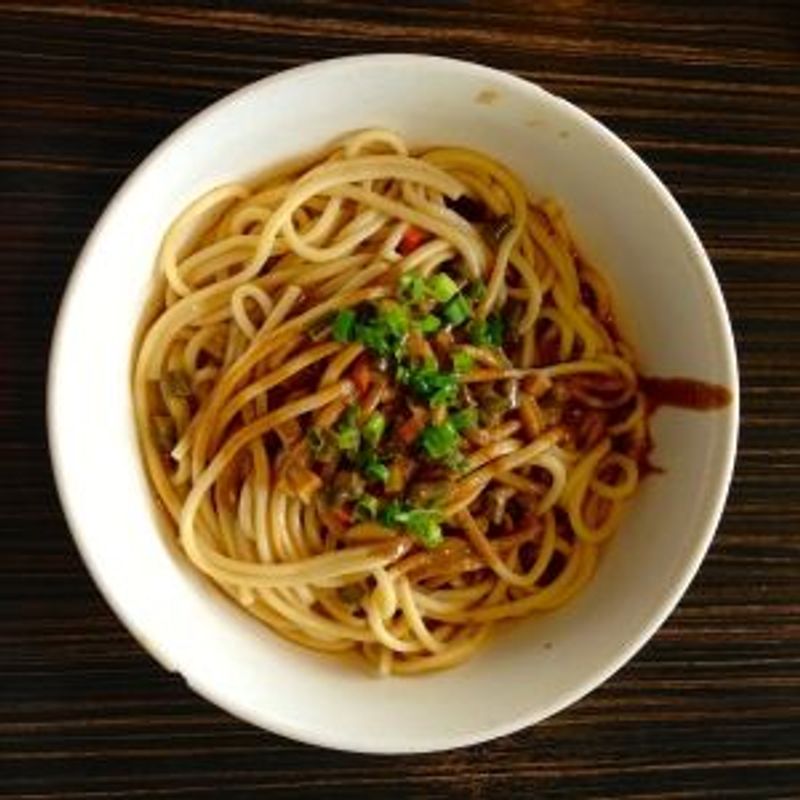
Hot dry noodles are a special delicacy in Wuhan, Hubei Province, and are usually served as breakfast. Its ingredients are relatively simple, and the cooking process is more demanding.
The cook usually boils the Chinese alkaline water noodles to eight mature in advance, drains the water, and then mixes it with sesame oil.
When diners order, the cook will put these pre-prepared semi-finished noodles into boiling water for dozens of seconds, let the noodles well-cooked, and then fish out. Finally, add sesame paste, soy sauce, pickled diced turnips, chopped onions, monosodium glutamate, and chili oil, and other materials to stir fully.
As its name suggests, it tastes dry. When you eat it, you may even feel that saliva is absorbed by noodles. However, because the surface of the noodles cooked in this way is very rough, all the seasonings are tightly attached to the noodles, which solves the problem that many other kinds of noodles taste only in the soup.
It is worth noting that, Hot Dry Noodles’s “Hot” means “Warm”. This is not a spicy noodles, of course, you can put some chili oil in it yourself.
Origin:
Hot dry noodles originated in 1930s, but there are two legends about who invented the noodles.
One of the inventors was Cai Mingwei, who opened a noodle shop to sell soup noodles. But because there are too many guests, people often have to wait in line for a long time to buy noodles.
In order to speed up the cooking of noodles, he invented a unique cooking technique: boil the noodles to medium cooked and remove them, cool them in cold water, and spread cooking oil on them.
When the guests want it, put these oiled semi-finished products in boiling water for dozens of seconds to finish the cooking.
Another legend is that, also in the 1930s, a cook named Li Bao accidentally spilled cooking oil on the cooked noodles after store closing. The next day, he cooked the oiled noodles and sold them, and the diners thought it was much better than before, so the method was fixed.
Price:
only 4-6 yuan (about $0.61-$1) in Wuhan
15-20 yuan (about $2.5-$3) in Beijing, Shanghai, Guangzhou and Shenzhen.
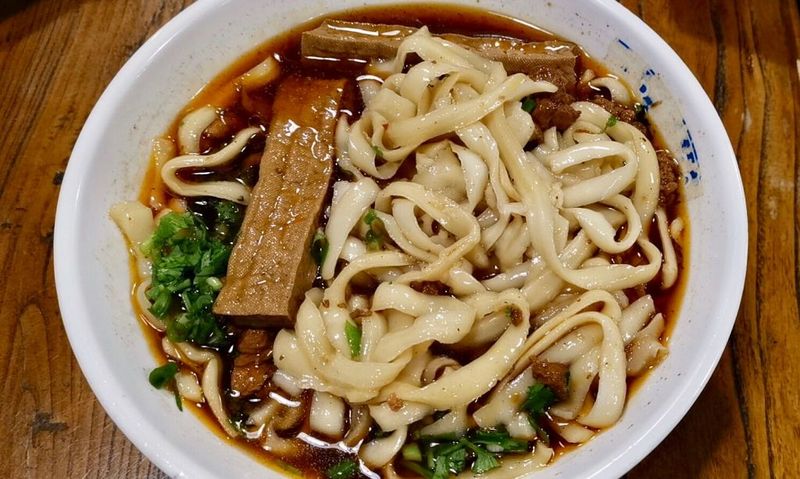
Shanxi Daoxiao Noodles
Taste and description:
Daoxiao Noodles is a kind of noodles with great appreciation in the cooking process.
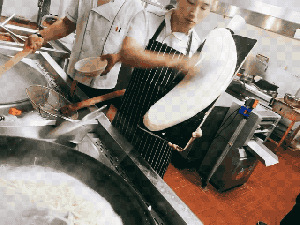
Daoxiao actually means “pare” (cut a piece gently on a surface with a knife) in Chinese. As the name suggests, when cooking Daoxiao Noodles, the cook will carry a large piece of wet dough on his shoulder, a knife-like piece of iron in the other hand quickly across the dough, and the cut noodles fall into the pot in front of the chef due to inertia.
This may remind you of Beijing Roast Duck, but in fact, I think Daoxiao Noodles is more enjoyable than Beijing Roast Duck.
The noodles made in this way are elastic and not neat enough, and each noodle has a different shape and thickness, which will bring people a pleasant surprise.
Daoxiao Noodles can be paired with a variety of base soup, so it can take on a completely different flavor. But because the noodles are thicker as a whole and have a smooth surface, the heavier ingredients will make it taste better.
Origin:
Daoxiao Noodles originated in the Yuan Dynasty, in which the Mongolians became the ruling class of China.
They were afraid that the Han Chinese in China would revolt, so they made strict restrictions on the use of props. Specifically, at that time, every 10 families shared one kitchen knife, which needed to be used in turn when cooking and was managed by the Mongolians.
Legend has it that an old woman at that time was preparing to cook noodles at home. She lit the stove, kneaded the flour into the dough, and asked her husband to fetch the knife. But the knife had been borrowed by others, so the old man picked up a thin piece of iron on the way home and said to his wife, “this is the only thing we can use.”
But this piece of iron is so soft that it is impossible to cut the dough like a normal kitchen knife. So they thought that the problem could be solved by speeding up movement. The method of making Daoxiao Noodls was born.
Price:
About 10 yuan (about $1.53) in Shanxi.
About 20 yuan (about $3) in Beijing, Shanghai, Guangzhou and Shenzhen.
Lanzhou Noodles
Taste and description:
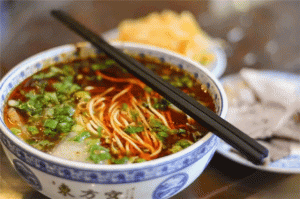
Lanzhou ramen noodles should come in five colors before stirring.
The Chinese word for Lanzhou Noodles is actually “兰州拉面”. If you know a little bit about Chinese, you will realize that it is a kind of Hand-Pulled Noodle.
This means that, like Japanese Ramen, chefs need to use both hands to stretch the dough into thin noodles. Lanzhou ramen has a formula: the first clear (soup), the second white (radish), the third green (coriander and garlic), the fourth red (pepper), the fifth yellow (noodles).
Lanzhou noodles’ soup is made from beef bone soup. So even if there is only a small amount of beef in the finished product, Lanzhou Noodles still has the meat flavor of beef. And since Lanzhou Noodles was invented by the Chinese Hui people, it is basically a Hui food.
Origin:
Lanzhou Noodles does not originate from Lanzhou, but from Henan. It evolved from beef noodles in Henan. In 1799, after finishing his studies in a school in Henan, the Hui people Maliuqi returned to their hometown in Lanzhou and brought this kind of noodles there. Since then, Lanzhou Noodles has become a delicacy of the Hui nationality in China.
In the following two hundred years, Lanzhou noodles experienced many changes and produced different branches. In 1915, the formula of the Hui people Ma Baozi won the competition and continues to this day.
In an additional legend, it was mentioned in the origin of Japanese-style ramen that the inventor of Japanese-style ramen seemed to invent it out of nostalgia for a kind of “bone soup noodles” he had eaten in northeast China.
But he doesn’t remember what bones Chinese chefs used to make noodle soup. Considering that almost only Lanzhou Noodles use animal bones to make base soup in China at that time, Japanese ramen most likely originated from Lanzhou noodles. But this claim has not been confirmed.
Price:
About 7 yuan (about $1.1) in Lanzhou
The price in Beijing, Shanghai, Guangzhou, and Shenzhen is about 16 yuan (about $2.45).
Noodles with Soy Bean Paste (Zhajiangmian).
Taste and description:
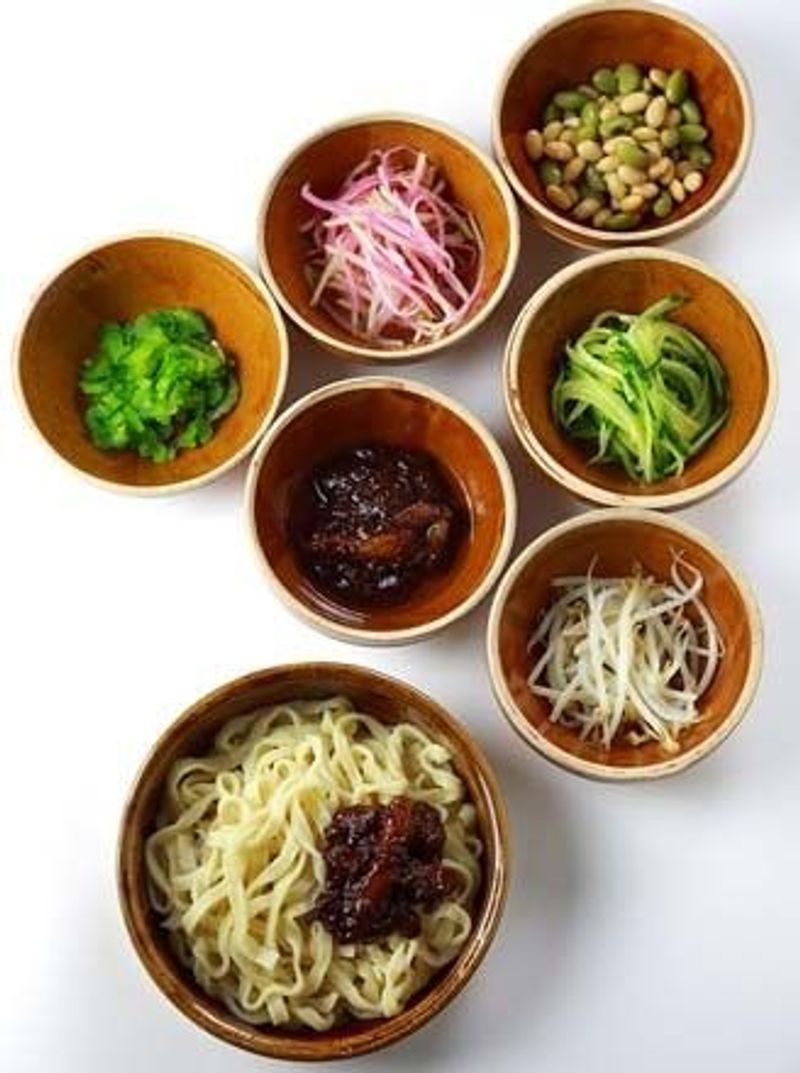
The literal translation of Zhajiangmian is actually Fried Sauce Noodles, Zhajiang is Fired Sauce in China.
The translation of the name Noodles with Soy Bean Paste is not accurate because it gives people the impression that it is a kind of noodles made from Korean Soy Bean Paste. But in fact, there is a big difference between Zhajiang and Soy Bean Paste.
First of all, you need to mix yellow soybean paste, doubanjiang in a certain proportion.
Then put them in the pan and stir-fry them with other ingredients. Depending on the ingredients, you will get different flavors of Zhajiang. But the Zhajiang used in the typical noodles soybean paste is fried with diced pork. Another popular ingredient is to stir-fry those sauces with eggs to make egg Zhajiang.
Mix the fried sauce with cooked noodles and Zhajiangmian is done.
But usually, Zhajiangmian has to go with many ingredients, such as shredded cucumber, shredded carrots, bean sprouts, celery, and so on. There are more than a dozen ingredients in Zhajiangmian, but in fact, no one will put that many ingredients on their plate at the same time.
Origin:
According to Wang Yongbin, a cultural scholar in Beijing, in his book “talking about Old Beijing”, there was a popular meal on Longfu Temple Street in Dongsi, Beijing in the Qing Dynasty.
This store has a unique noodle called “cold rotten meat noodles” which is very popular, especially in the hot summer. This is recognized as the starting point for Beijing Zhajiangmian because the ingredients and cooking methods it uses are almost no different from those of today’s Zhajiangmian.
But the real popularity of Zhajiangmian seemed to be in 1950s, when China had relatively abundant grain stocks but a shortage of meat. Beijingers found that Zhajiangmian’s cooking method can use the least amount of meat to fill the whole bowl of noodles with meat flavor, so Zhajiangmian began to become one of the representative foods in Beijing.
Price:
15-20 yuan (about $2.3-$3.06)
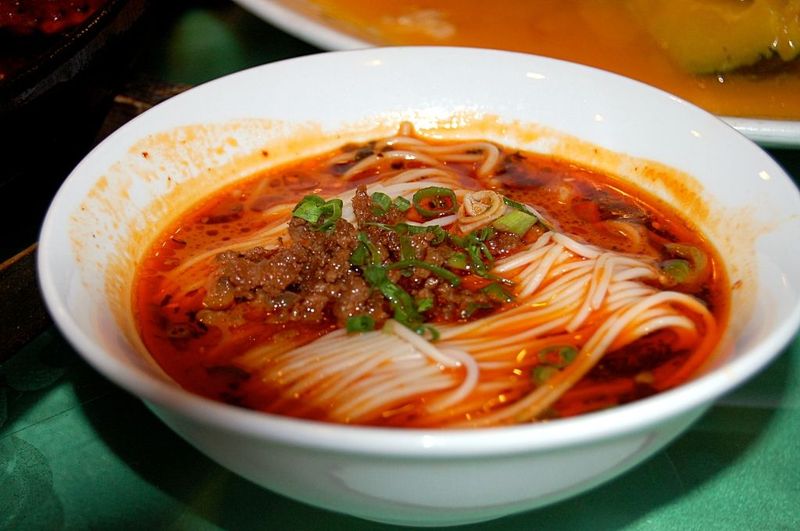
Dandan noodles
Taste and description:
Like any other food from Sichuan, Dandan Noodles is spicy.
The basic ingredients of Dandan Noodles are chili oil, sesame sauce, minced meat, Sichuan Preserved Vegetables, chopped peanut kernels, soy sauce, chopped onions and Pea sprouts.
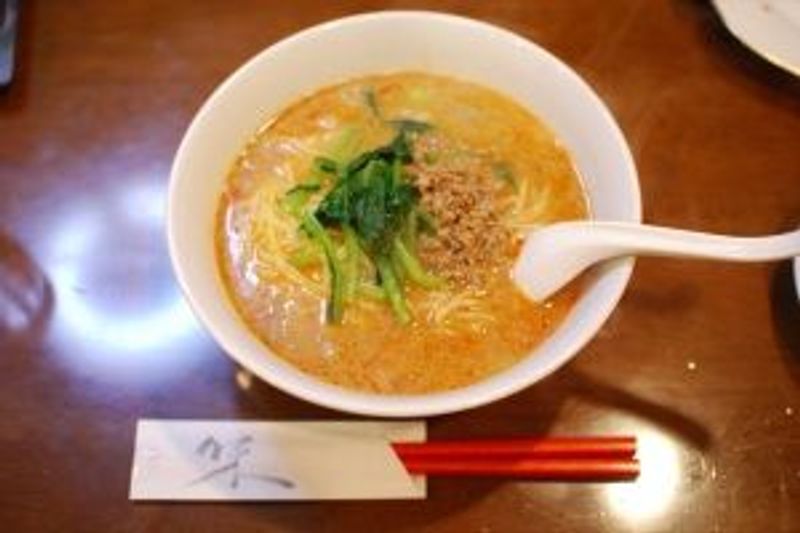
Dandan Noodles in the Japanese restaurant, just by the color, you can see that it is not very spicy.
In addition, Dandan Noodles is one of the typical Japanese Chinese cuisines. It is hard to see authentic Dandan Noodles outside China. Most of them are Japanese improved versions. The Japanese version of Dandan Noodles is hardly spicy and tastes lighter and sweeter.
If you have ever eaten Dandan Noodles, overseas and ordered a bowl of Dandan Noodls, in China to relive that taste, you may be attacked by chili peppers.
Origin:
The origin of Dandan Noodles has not yet been determined, but the origin of its name is determined. The Chinese character for Dan is “担”, which is a kind of tool to carry more packages. It is said that the person who first sold noodles in this way was a small businessman named Chen Baobao in the late Qing Dynasty.
Chen baobao used Dan to carry noodles and sell them on the streets of Zigong, so the noodles were named Dandan Noodles.
At that time, Dandan Noodles merchants would put two pots at both ends of the Dan, and the middle of the pot would be separated by a metal plate into two parts, with cooked noodles on one side and soup on the other.
But now, no one will sell Dandan Noodles in this way, only the name has been retained.
Price: about 15 yuan (about $2.3)
- Author:NotionNext
- URL:https://pandayoo.com/2020/12/21/the-5-most-popular-chinese-noodles
- Copyright:All articles in this blog, except for special statements, adopt BY-NC-SA agreement. Please indicate the source!